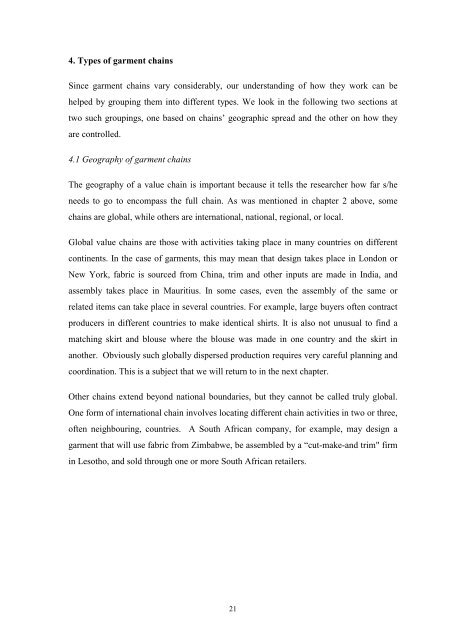McCormick+Schmitz Handbook for value chain research on - PACA
McCormick+Schmitz Handbook for value chain research on - PACA
McCormick+Schmitz Handbook for value chain research on - PACA
You also want an ePaper? Increase the reach of your titles
YUMPU automatically turns print PDFs into web optimized ePapers that Google loves.
4. Types of garment <str<strong>on</strong>g>chain</str<strong>on</strong>g>s<br />
Since garment <str<strong>on</strong>g>chain</str<strong>on</strong>g>s vary c<strong>on</strong>siderably, our understanding of how they work can be<br />
helped by grouping them into different types. We look in the following two secti<strong>on</strong>s at<br />
two such groupings, <strong>on</strong>e based <strong>on</strong> <str<strong>on</strong>g>chain</str<strong>on</strong>g>s’ geographic spread and the other <strong>on</strong> how they<br />
are c<strong>on</strong>trolled.<br />
4.1 Geography of garment <str<strong>on</strong>g>chain</str<strong>on</strong>g>s<br />
The geography of a <str<strong>on</strong>g>value</str<strong>on</strong>g> <str<strong>on</strong>g>chain</str<strong>on</strong>g> is important because it tells the <str<strong>on</strong>g>research</str<strong>on</strong>g>er how far s/he<br />
needs to go to encompass the full <str<strong>on</strong>g>chain</str<strong>on</strong>g>. As was menti<strong>on</strong>ed in chapter 2 above, some<br />
<str<strong>on</strong>g>chain</str<strong>on</strong>g>s are global, while others are internati<strong>on</strong>al, nati<strong>on</strong>al, regi<strong>on</strong>al, or local.<br />
Global <str<strong>on</strong>g>value</str<strong>on</strong>g> <str<strong>on</strong>g>chain</str<strong>on</strong>g>s are those with activities taking place in many countries <strong>on</strong> different<br />
c<strong>on</strong>tinents. In the case of garments, this may mean that design takes place in L<strong>on</strong>d<strong>on</strong> or<br />
New York, fabric is sourced from China, trim and other inputs are made in India, and<br />
assembly takes place in Mauritius. In some cases, even the assembly of the same or<br />
related items can take place in several countries. For example, large buyers often c<strong>on</strong>tract<br />
producers in different countries to make identical shirts. It is also not unusual to find a<br />
matching skirt and blouse where the blouse was made in <strong>on</strong>e country and the skirt in<br />
another. Obviously such globally dispersed producti<strong>on</strong> requires very careful planning and<br />
coordinati<strong>on</strong>. This is a subject that we will return to in the next chapter.<br />
Other <str<strong>on</strong>g>chain</str<strong>on</strong>g>s extend bey<strong>on</strong>d nati<strong>on</strong>al boundaries, but they cannot be called truly global.<br />
One <str<strong>on</strong>g>for</str<strong>on</strong>g>m of internati<strong>on</strong>al <str<strong>on</strong>g>chain</str<strong>on</strong>g> involves locating different <str<strong>on</strong>g>chain</str<strong>on</strong>g> activities in two or three,<br />
often neighbouring, countries. A South African company, <str<strong>on</strong>g>for</str<strong>on</strong>g> example, may design a<br />
garment that will use fabric from Zimbabwe, be assembled by a “cut-make-and trim" firm<br />
in Lesotho, and sold through <strong>on</strong>e or more South African retailers.<br />
21














